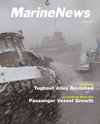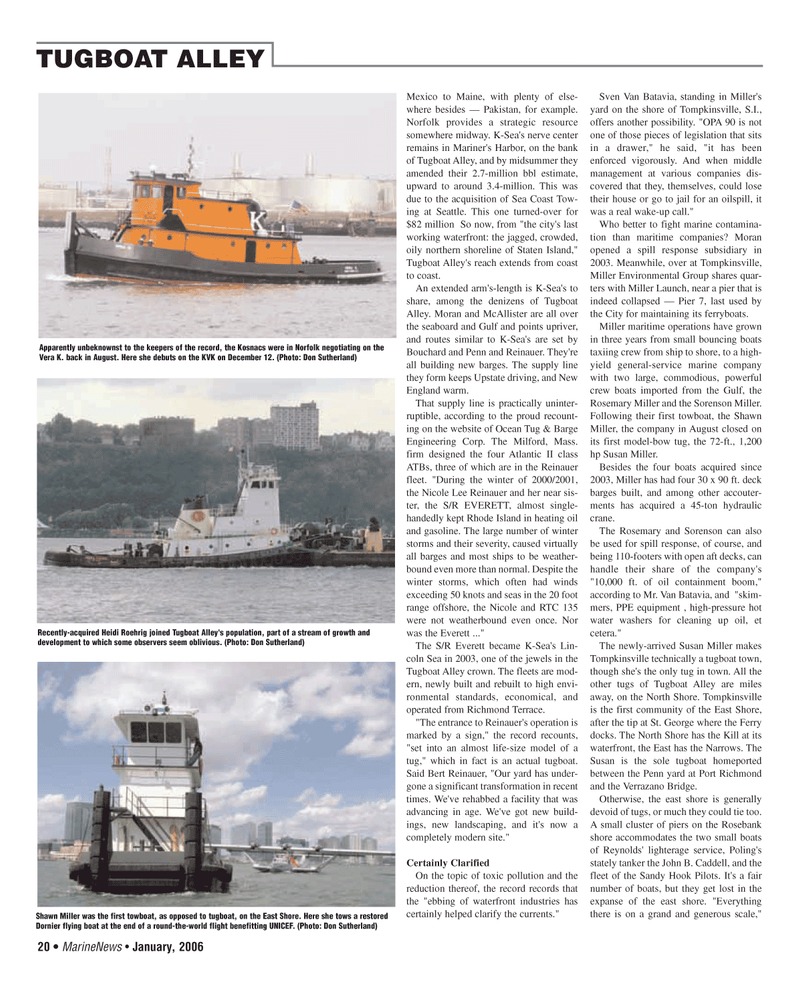
Page 20: of Marine News Magazine (January 2, 2006)
Read this page in Pdf, Flash or Html5 edition of January 2, 2006 Marine News Magazine
TUGBOAT ALLEY
Mexico to Maine, with plenty of else- where besides — Pakistan, for example.
Norfolk provides a strategic resource somewhere midway. K-Sea's nerve center remains in Mariner's Harbor, on the bank of Tugboat Alley, and by midsummer they amended their 2.7-million bbl estimate, upward to around 3.4-million. This was due to the acquisition of Sea Coast Tow- ing at Seattle. This one turned-over for $82 million So now, from "the city's last working waterfront: the jagged, crowded, oily northern shoreline of Staten Island,"
Tugboat Alley's reach extends from coast to coast.
An extended arm's-length is K-Sea's to share, among the denizens of Tugboat
Alley. Moran and McAllister are all over the seaboard and Gulf and points upriver, and routes similar to K-Sea's are set by
Bouchard and Penn and Reinauer. They're all building new barges. The supply line they form keeps Upstate driving, and New
England warm.
That supply line is practically uninter- ruptible, according to the proud recount- ing on the website of Ocean Tug & Barge
Engineering Corp. The Milford, Mass. firm designed the four Atlantic II class
ATBs, three of which are in the Reinauer fleet. "During the winter of 2000/2001, the Nicole Lee Reinauer and her near sis- ter, the S/R EVERETT, almost single- handedly kept Rhode Island in heating oil and gasoline. The large number of winter storms and their severity, caused virtually all barges and most ships to be weather- bound even more than normal. Despite the winter storms, which often had winds exceeding 50 knots and seas in the 20 foot range offshore, the Nicole and RTC 135 were not weatherbound even once. Nor was the Everett ..."
The S/R Everett became K-Sea's Lin- coln Sea in 2003, one of the jewels in the
Tugboat Alley crown. The fleets are mod- ern, newly built and rebuilt to high envi- ronmental standards, economical, and operated from Richmond Terrace. "The entrance to Reinauer's operation is marked by a sign," the record recounts, "set into an almost life-size model of a tug," which in fact is an actual tugboat.
Said Bert Reinauer, "Our yard has under- gone a significant transformation in recent times. We've rehabbed a facility that was advancing in age. We've got new build- ings, new landscaping, and it's now a completely modern site."
Certainly Clarified
On the topic of toxic pollution and the reduction thereof, the record records that the "ebbing of waterfront industries has certainly helped clarify the currents."
Sven Van Batavia, standing in Miller's yard on the shore of Tompkinsville, S.I., offers another possibility. "OPA 90 is not one of those pieces of legislation that sits in a drawer," he said, "it has been enforced vigorously. And when middle management at various companies dis- covered that they, themselves, could lose their house or go to jail for an oilspill, it was a real wake-up call."
Who better to fight marine contamina- tion than maritime companies? Moran opened a spill response subsidiary in 2003. Meanwhile, over at Tompkinsville,
Miller Environmental Group shares quar- ters with Miller Launch, near a pier that is indeed collapsed — Pier 7, last used by the City for maintaining its ferryboats.
Miller maritime operations have grown in three years from small bouncing boats taxiing crew from ship to shore, to a high- yield general-service marine company with two large, commodious, powerful crew boats imported from the Gulf, the
Rosemary Miller and the Sorenson Miller.
Following their first towboat, the Shawn
Miller, the company in August closed on its first model-bow tug, the 72-ft., 1,200 hp Susan Miller.
Besides the four boats acquired since 2003, Miller has had four 30 x 90 ft. deck barges built, and among other accouter- ments has acquired a 45-ton hydraulic crane.
The Rosemary and Sorenson can also be used for spill response, of course, and being 110-footers with open aft decks, can handle their share of the company's "10,000 ft. of oil containment boom," according to Mr. Van Batavia, and "skim- mers, PPE equipment , high-pressure hot water washers for cleaning up oil, et cetera."
The newly-arrived Susan Miller makes
Tompkinsville technically a tugboat town, though she's the only tug in town. All the other tugs of Tugboat Alley are miles away, on the North Shore. Tompkinsville is the first community of the East Shore, after the tip at St. George where the Ferry docks. The North Shore has the Kill at its waterfront, the East has the Narrows. The
Susan is the sole tugboat homeported between the Penn yard at Port Richmond and the Verrazano Bridge.
Otherwise, the east shore is generally devoid of tugs, or much they could tie too.
A small cluster of piers on the Rosebank shore accommodates the two small boats of Reynolds' lighterage service, Poling's stately tanker the John B. Caddell, and the fleet of the Sandy Hook Pilots. It's a fair number of boats, but they get lost in the expanse of the east shore. "Everything there is on a grand and generous scale,"
Apparently unbeknownst to the keepers of the record, the Kosnacs were in Norfolk negotiating on the
Vera K. back in August. Here she debuts on the KVK on December 12. (Photo: Don Sutherland)
Recently-acquired Heidi Roehrig joined Tugboat Alley's population, part of a stream of growth and development to which some observers seem oblivious. (Photo: Don Sutherland)
Shawn Miller was the first towboat, as opposed to tugboat, on the East Shore. Here she tows a restored
Dornier flying boat at the end of a round-the-world flight benefitting UNICEF. (Photo: Don Sutherland) 20 • MarineNews • January, 2006
JANUARY MN2006 3(17-24).qxd 1/4/2006 7:36 PM Page 20

 19
19

 21
21
